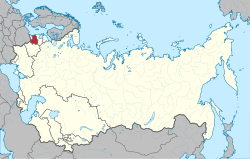
Back Litause Sosialistiese Sowjetrepubliek Afrikaans جمهورية ليتوانيا الاشتراكية السوفيتية Arabic República Socialista Soviética de Lituania AST Litva Sovet Sosialist Respublikası Azerbaijani لیتوانی شوروی سوسیالیست جومهوریتی AZB Tarību Lietova BAT-SMG Літоўская Савецкая Сацыялістычная Рэспубліка Byelorussian Летувіская Савецкая Сацыялістычная Рэспубліка BE-X-OLD Литовска съветска социалистическа република Bulgarian RSS Lituania Breton
Lithuanian Soviet Socialist Republic Lietuvos Tarybų Socialistinė Respublika (Lithuanian) Литовская Советская Социалистическая Республика (Russian) | |||||||||
|---|---|---|---|---|---|---|---|---|---|
| 1940–1941 1944–1990 | |||||||||
Flag
(1953–1988) State emblem
(1940–1990) | |||||||||
| Motto: Visų šalių proletarai, vienykitės! (Lithuanian) "Workers of the world, unite!" | |||||||||
| Anthem: Tautiška giesmė (1944–1950, 1988–1990) Anthem of the Lithuanian Soviet Socialist Republic (1950–1988) | |||||||||
 Location of annexed Lithuania (red) within the Soviet Union | |||||||||
| Status | Internationally unrecognized territory occupied by the Soviet Union (1940–1941; 1944–1990) | ||||||||
| Capital | Vilnius | ||||||||
| Common languages | Lithuanian · Russian | ||||||||
| Religion | Secular state (de jure) State atheism (de facto) | ||||||||
| Demonym(s) | Lithuanian Soviet | ||||||||
| Government | Unitary Marxist-Leninist one-party soviet socialist republic (1940–1989) Unitary multi-party parliamentary republic (1989–1990) | ||||||||
| First Secretary | |||||||||
• 1940–1974 | Antanas Sniečkus | ||||||||
• 1974–1987 | Petras Griškevičius | ||||||||
• 1987–1988 | Ringaudas Songaila | ||||||||
• 1988–1990 | Algirdas Brazauskas | ||||||||
| Head of state | |||||||||
• 1940–1967 (first) | Justas Paleckis | ||||||||
• 1990 (last) | Vytautas Landsbergis | ||||||||
| Head of government | |||||||||
• 1940–1956 (first) | Mečislovas Gedvilas | ||||||||
• 1985–1990 (last) | Vytautas Sakalauskas | ||||||||
| Legislature | Supreme Soviet | ||||||||
| Historical era | World War II · Cold War | ||||||||
| 16 June 1940 | |||||||||
• SSR established | 21 July 1940 | ||||||||
| 3 August 1940 | |||||||||
| June 1941 | |||||||||
• Soviet re-occupation SSR re-established | September–November 1944 | ||||||||
| 1988 | |||||||||
• Sovereignty declared | 18 May 1989 | ||||||||
| 11 March 1990 | |||||||||
| Area | |||||||||
| 1989 | 65,200 km2 (25,200 sq mi) | ||||||||
| Population | |||||||||
• 1989 | 3,689,779 | ||||||||
| Currency | Soviet rouble (Rbl) (SUR) | ||||||||
| Calling code | +7 012 | ||||||||
| |||||||||
| Today part of | Lithuania | ||||||||
The Lithuanian Soviet Socialist Republic (Lithuanian SSR; Lithuanian: Lietuvos Tarybų Socialistinė Respublika; Russian: Литовская Советская Социалистическая Республика, romanized: Litovskaya Sovetskaya Sotsialisticheskaya Respublika), also known as Soviet Lithuania or simply Lithuania, was de facto one of the constituent republics of the Soviet Union between 1940–1941 and 1944–1990. After 1946, its territory and borders mirrored those of today's Republic of Lithuania, with the exception of minor adjustments to its border with Belarus.[1]
During World War II, the previously independent Republic of Lithuania was occupied by the Red Army on 16 June 1940, in conformity with the terms of the 23 August 1939 Molotov–Ribbentrop Pact, and established as a puppet state on 21 July.[2] Between 1941 and 1944, the German invasion of the Soviet Union caused its de facto dissolution. However, with the retreat of the Germans in 1944–1945, Soviet hegemony was re-established and continued for forty-five years. As a result, many Western countries continued to recognize Lithuania as an independent, sovereign de jure state subject to international law, represented by the legations appointed by the pre-1940 Baltic states, which functioned in various places through the Lithuanian Diplomatic Service.
On 18 May 1989, the Lithuanian SSR declared itself to be a sovereign state, though still part of the USSR. On 11 March 1990, the Republic of Lithuania was re-established as an independent state, the first Soviet Republic to leave Moscow and leading other states to do so. Lithuania considered the Soviet occupation and annexation illegal and, like the other two Baltic States, claimed state continuity. This legal continuity has been recognised by most Western powers. The Soviet authorities considered the independence declaration illegal, but after the January Events in Lithuania and failed 1991 Soviet coup attempt in Moscow, the Soviet Union itself recognized Lithuanian independence on 6 September 1991.
- ^ "Закон о принятии Литовской Советской Социалистической Республики в Союз Советских Социалистических Республик. от 3 августа 1940 года".
- ^ Ronen, Yaël (2011). Transition from Illegal Regimes Under International Law. Cambridge University Press. p. 17. ISBN 978-0-521-19777-9.

